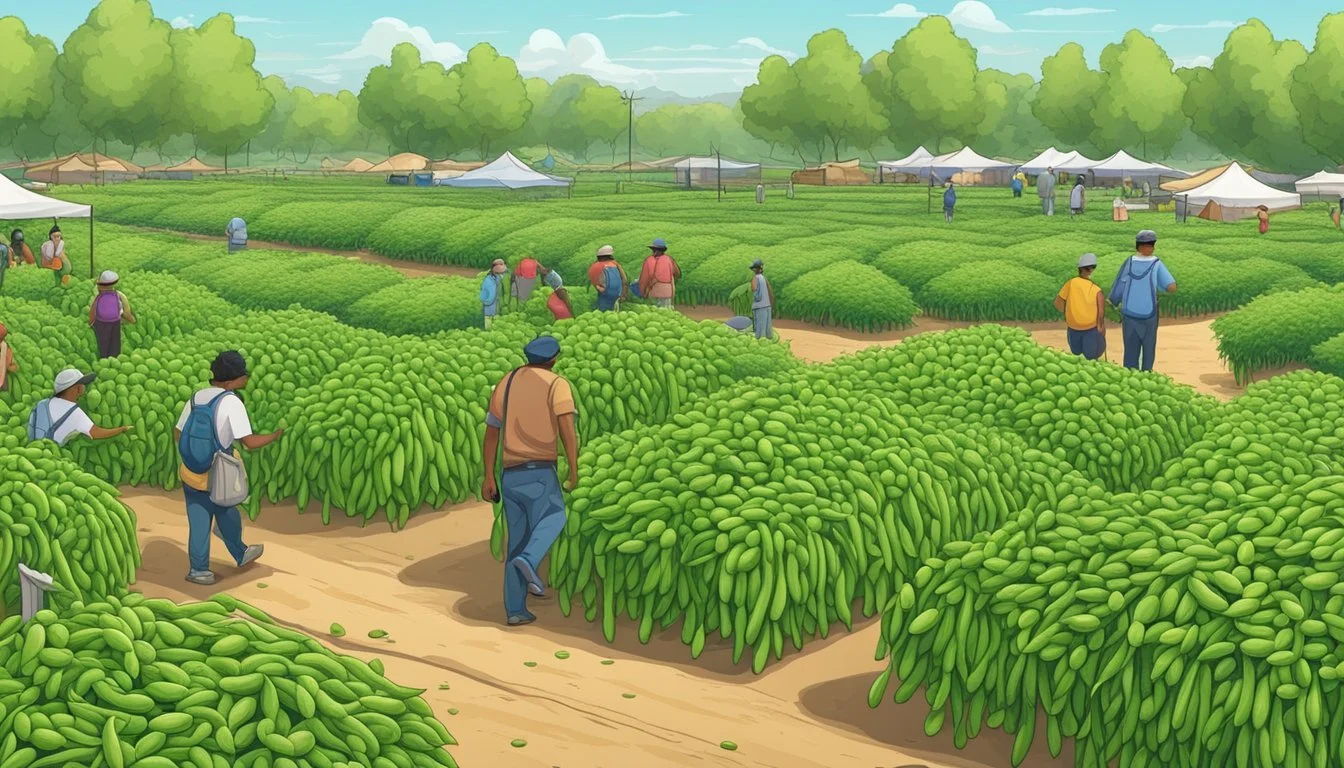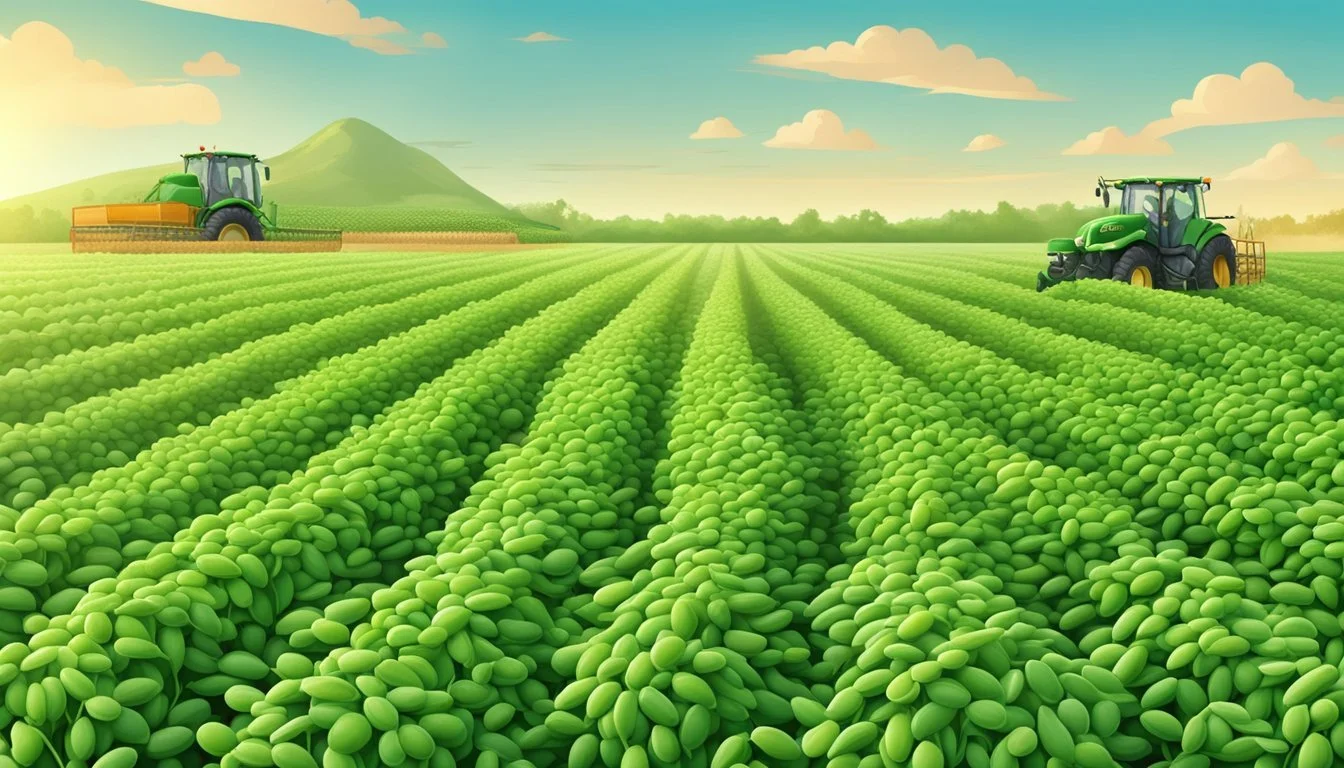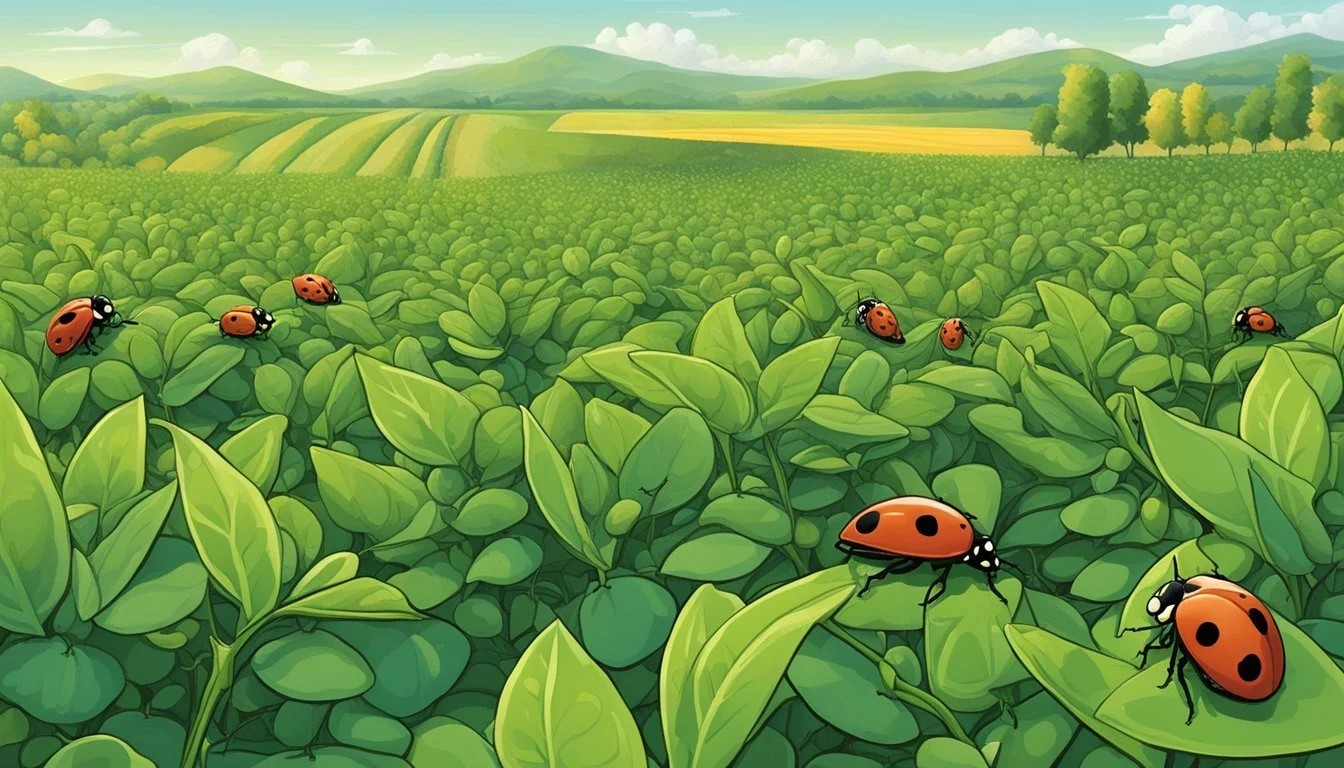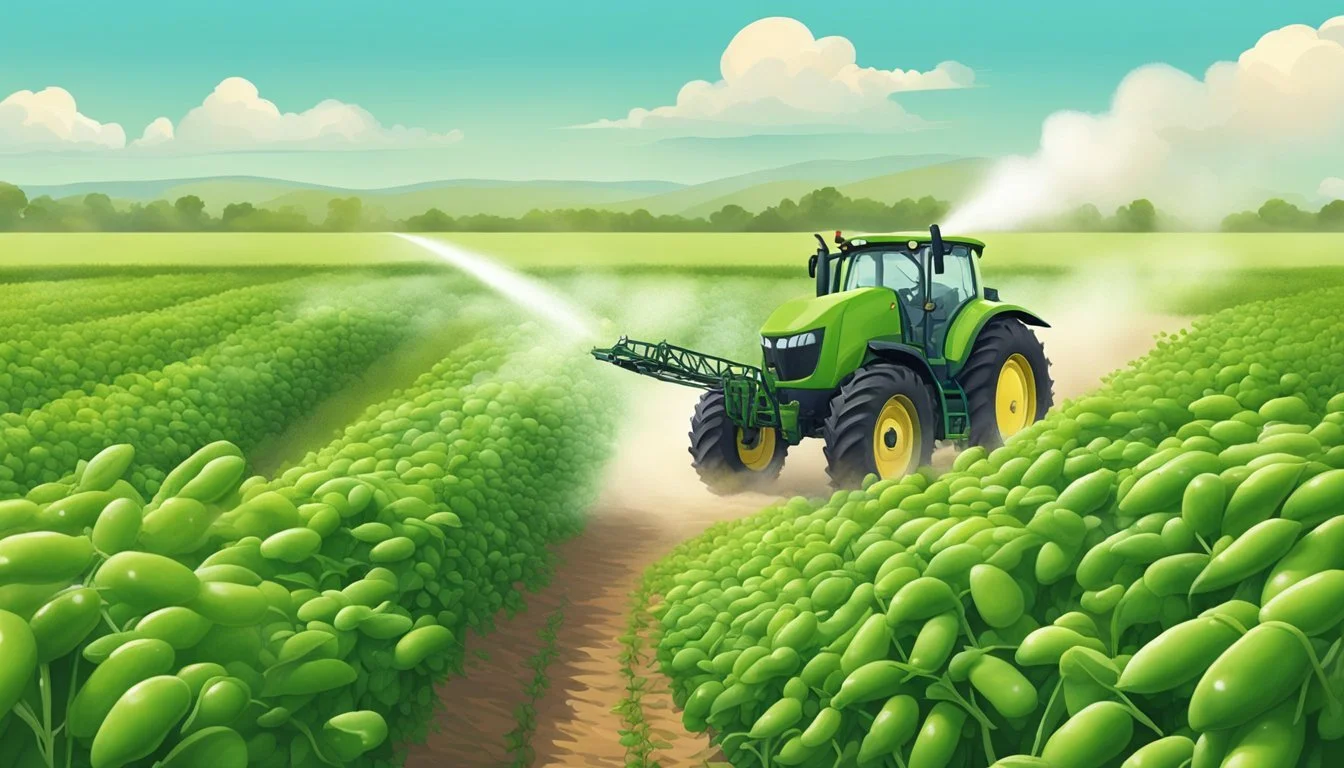Pest Control for Edamame
Effective Strategies for Young Soybean Protection
Edamame, the young, green soybeans often found in pods, are not just a delicious snack but also a valuable crop packed with protein. Growing edamame can be quite rewarding; however, like any crop, they are susceptible to various pests that can affect their quality and yield. Effective pest control in edamame is crucial to ensure that these protein-rich beans can reach their full potential, both in the garden and on the plate.
To maintain a healthy edamame crop, farmers and gardeners must identify and manage a range of insect and mite pests. These pests can significantly impact the plants at different growth stages, from seedlings to pods. Implementing an integrated pest management strategy, which includes monitoring and timely interventions, can help protect the soybeans while minimizing the use of harsh chemicals. With the right approach, pests can be managed effectively, allowing for a bountiful harvest of nutritious edamame soybeans.
Understanding Edamame
Edamame are young soybeans, harvested before they harden, offering a healthy inclusion to the diet and boasting a straightforward cultivation process. They grow best in full sun and are a rewarding crop for many gardeners.
Cultivation Basics
Edamame, or Glycine max, is best planted in full sun and requires moderate soil moisture to ensure proper germination. Planting should occur after the last frost to avoid damaging the young plants. For optimal growth, maintaining consistent soil moisture is key, but excessive water should be avoided to prevent root issues.
Growth and Development
During the growing season, edamame plants develop in various maturity groups, adapting to diverse climates. Adequate soil moisture is crucial for the beans' development, ensuring they become plump and attain a bright green hue upon harvest.
Edamame Varieties
There are several soybean varieties available to growers. Varieties like 'Envy', 'Chiba Green', and 'Midori Giant' are commonly selected for their flavor and adaptability. Resistant varieties may also be chosen for their ability to thrive in specific regional challenges such as pests or soil conditions.
Nutritional Profile
Edamame beans are a dense nutritional source, high in protein, fiber, iron, and nitrogen-fixing capabilities, which benefits the soil quality for future crops. They're enjoyed for their creamy texture and beneficial health properties.
Harvesting Techniques
Harvesting edamame requires timing; the beans must be picked when they're bright green and the pods are plump. Techniques vary, but they generally include hand-picking the pods from the stem, being careful not to damage the plant in case of a staggered harvest.
Pest Management Strategies
Effective pest management is crucial in protecting edamame crops from yield losses due to insect pests such as aphids, stink bugs, soybean loopers, and various lepidopterans. By recognizing common pests and employing cultural, biological, and chemical control methods, growers can implement Integrated Pest Management (IPM) strategies to safeguard their harvests.
Recognizing Common Pests
Identifying insect pests is the first line of defense in edamame cultivation. Soybean aphids can severely stunt growth, leading to lower yields. Stink bugs are notorious for their feeding on young pods, while grasshoppers may defoliate plants. Growers must also monitor for lepidopterans such as the soybean looper and velvetbean caterpillar, which can cause extensive damage to foliage and pods.
Cultural Control Methods
Implementing cultural practices can reduce pest populations. Crop rotation disrupts pest life cycles, soil fertility management, and weed control create less favorable conditions for pests. The use of mulch and compost can improve plant health, reducing susceptibility to pest attacks. Further, staking of plants can make them less accessible to ground pests.
Biological Control Techniques
Biological control incorporates natural predators and parasites to combat pest populations. Insect heroes, such as lady beetles and parasitic wasps, are allies in controlling aphids and caterpillars. For instance, implementing biological control against soybean aphids with lady beetles can reduce the reliance on chemical interventions.
Chemical Control Measures
When necessary, chemical controls like s-metolachlor and diflubenzuron may be used with caution. It is essential to select insecticides that target the specific pests present, and to apply them responsibly to minimize their impact on beneficial insects and the environment. Fertilizers, especially nitrogen fertilizers, should be managed to avoid excessive vegetative growth, which may attract pests.
Integrated Pest Management
Integrated Pest Management (IPM) is a holistic approach that combines all methods of pest control, focusing on long-term prevention and minimal impact on the environment. It includes scouting to detect pests early, cultural techniques to prevent infestations, biological control to utilize natural predators, and chemical measures only as a last resort. Effective soybean pest management through IPM minimizes yield losses and enhances sustainable production.
Optimizing Growing Conditions
Ensuring that edamame (young soybeans) have optimal growing conditions is key to a healthy harvest. This includes managing soil fertility, providing adequate water, controlling pests and diseases, and employing strategic planting methods.
Soil and Fertility
Edamame thrives in well-draining soil with a pH between 6.0 and 6.8. It is important to test the soil before planting to adjust pH levels and amend with compost to improve nutrition. Implementing crop rotation with non-legume crops can prevent soil depletion and reduce disease risk, maintaining high soil fertility.
Soil type: Loamy
pH range: 6.0 - 6.8
Amendments: Compost, as needed
Water and Irrigation
Consistent irrigation ensures that edamame receives enough soil moisture without waterlogging. During the germination and flowering stages, edamame requires more frequent watering. Drip irrigation is ideal for delivering water directly to the roots and preserving soil structure.
Water needs: 1 inch per week
Preferred method: Drip irrigation
Weed and Disease Control
Timely weed management is critical in preventing weed competition and promoting air circulation to reduce disease. Mulching helps suppress weeds and retains moisture. To mitigate disease, avoid planting in areas where related crops like bush beans or snap beans were recently grown.
Weed control: Mulching, hand-weeding
Disease prevention: Rotation away from bean crops
Planting Strategies
Planting edamame in early planting or late spring helps to avoid peak pest times. Choosing the right time and method for planting can also lower the risk of stink bug infestations. Correct spacing is necessary to maximize air flow and reduce diseases.
Suitable planting times: Early season or late spring
Spacing: According to variety specifications
Post-Harvest Processing
After edamame is harvested, efficient post-harvest processing is crucial to maintain the quality, flavor, and texture of these young, green soybeans. This stage includes proper storage and preservation techniques as well as preparation for culinary uses.
Storage and Preservation
Immediately after harvest, edamame should be cooled and stored to preserve its bright green color and fresh taste. To maintain optimal flavor and prevent spoilage, cooling and blanching should be done shortly after harvest. Best practices for storage include:
Cooling: Rapidly reduce the temperature of edamame to slow enzymatic activity.
Blanching: Submerge in boiling water for a short time, then cool quickly to preserve color and texture.
Storage: Keep in a refrigerated environment at high humidity levels.
Proper storage ensures that edamame retains the tender texture akin to fresh peas and stays suitable for consumption or further processing into products like soymilk and tofu.
Culinary Uses
Edamame is treasured for its versatility in the kitchen. These green soybeans can be served as a snack or incorporated into a variety of dishes. Key points for culinary preparation include:
Boiling: Often boiled in saltwater, which infuses the edamame with a savory taste.
Versatility: Can be served whole as a snack or appetizer, or the beans can be shelled and added to salads, stir-fries, and soups.
When prepared correctly, edamame offers a unique combination of a buttery texture and a slightly nutty flavor, making it a favorite in many culinary contexts.
Environmental Impact of Edamame Cultivation
Edamame, being legumes, contribute positively to agricultural ecosystems through nitrogen fixation, which benefits soil health and reduces the need for synthetic fertilizers.
Sustainable Practices
Edamame, or immature soybeans, is seen as a low-maintenance crop that can play a role in sustainable agriculture. The cultivation of edamame can have several potential positive effects on the environment. As legumes, they have the ability to fix nitrogen from the atmosphere into the soil through a symbiotic relationship with rhizobia bacteria. This nitrogen fixation can enrich the soil, reducing the need for nitrogen fertilizers, which are often associated with environmental pollution.
Moreover, these young soybeans typically require fewer pesticides than many other crops. The reduced chemical usage not only lessens the crop's environmental footprint but also helps in maintaining the balance within the local ecosystem, by protecting beneficial insect populations and reducing soil and water contamination.
The cultivation methods can also contribute to soil conservation through practices like crop rotation, where edamame is planted in succession with other crops. This practice helps in preventing soil erosion, maintaining soil fertility, and suppressing weeds naturally, contributing to a healthier agricultural landscape.
In addition, edamame can be included in intercropping systems, where other crops are grown alongside them. This diversification of crops can lead to a more resilient ecosystem, capable of withstanding pests and diseases, while also promoting biodiversity.
Market Potential and Economic Viability
In evaluating the market for edamame, it's essential to consider consumer demand and the crop's economic return potential. Factors such as the protein content of edamame and its status as a nutritious legume have bearing on its marketability and profitability in regions like North America.
Demand for Edamame
Edamame, also known as green soybeans, has seen a growing popularity as a protein-rich, healthy snack and ingredient in North America. The consumer trend toward plant-based diets and whole foods has contributed to the increased demand for this versatile legume. The legumes sector continues to benefit from a health-conscious demographic that seeks out nutrient-dense options with a lower environmental impact, positioning edamame as a favorable crop in the market.
Yield Potential and Profitability
The profitability of edamame cultivation hinges on yield potential and market pricing. Research suggests that under ideal conditions, farmers may experience a range of financial outcomes, with potential returns extending from slightly negative to significantly positive per acre. This variability in profitability underscores the importance of strategic market planning and careful management of production costs.
Yield Potential: The yield of edamame can vary significantly based on agronomic practices, seed quality, and regional climate factors. In North America, efforts to adapt cultivation techniques to local conditions continue to advance, potentially increasing yield potential.
Profitability: Growers must consider the cost of production versus the price for which edamame can be sold. Though challenging, identifying the right market channels can enhance profitability, especially given the crop's niche appeal.
In summary, edamame presents a feasible economic opportunity for growers capable of navigating market demand and effectively managing their farm's production parameters.
Regulatory and Compliance Issues
When cultivating edamame, or young soybeans, growers must navigate a complex framework of regulations designed to ensure both the safety and efficacy of pest control measures, as well as the integrity of the soybean varieties being planted.
Seed Regulation and Certification
Seed certification standards are in place to guarantee that soybean varieties are free from designated pests and meet quality requirements. The certification process involves several steps to ensure that the genetic purity and germination rates adhere to prescribed benchmarks. This not only helps maintain the health of crops but also aids in preserving the environment by reducing the spread of plant diseases.
Pesticide Use Compliance
Pesticide compliance governs the safe application of chemicals to manage pests in edamame cultivation. Integrated Pest Management (IPM) strategies are crucial for growers, offering a framework to apply pesticides in an environmentally responsible manner. Manufacturers and applicators are expected to abide by the Environmental Protection Agency (EPA) guidelines, ensuring the label's instructions are meticulously followed to minimize potential harm to beneficial organisms and reduce the risk of developing resistant pest populations.
Advances in Edamame Research
Recent research efforts have shed light on genetic advancements and developing resistance to pests and diseases in edamame. These efforts are crucial in improving the sustainability and efficiency of edamame production.
Breeding and Genetic Improvements
Researchers have made significant strides in the breeding and genetic improvement of edamame cultivars. By focusing on the genotypic selection, they have successfully introduced varieties that are better suited to local climates as well as consumer preferences. For instance, maturity groups have been broadened to ensure a more flexible planting and harvest schedule, which is particularly beneficial for growers in varying climates, including those in North Carolina. Studies have also delved into the genetic makeup of edamame to identify traits conducive to higher yields and better quality edamame.
Resistance to Pests and Diseases
The development of resistant varieties of edamame has been a key area of focus to combat the negative impacts of insects and diseases. For example, research on soybean cyst nematode — a notable pest — has led to the introduction of cultivars that serve as poor host plants, effectively reducing the pest's life cycle. Substantial progress has also been made in creating edamame varieties that are resilient against common insects and diseases, thereby reducing the dependency on chemical pesticides and contributing to more sustainable cultivation practices.
Global Edamame Trade Dynamics
The global trade of edamame, also known as green soybeans, is influenced by numerous factors, pertaining particularly to import-export balances and the shaping force of consumer preferences that dictate market demand.
Import and Export Trends
Edamame's journey from local delicacy to international commodity is marked by significant trade activity. Traditionally grown in Asian countries, specifically China and Japan, where it has been a staple for centuries, the export of edamame has seen a substantial incline due to its burgeoning popularity globally. The United States, among other countries, has emerged as a primary importer, owing to the crop's health benefits and demand as a plant-based protein. Despite the noticeable imports, there has been an increasing interest in domestic production, as evidenced by research efforts in places like Virginia aimed at bolstering local output to mitigate reliance on international markets.
The texture and flavor profile of edamame has also led to its derivative products like soymilk and tofu garnering increased export activity, as manufacturers seek to expand into new and existing markets that show an affinity for soy-based food items.
Influence of Consumer Preferences
Consumer preferences have a powerful impact on global edamame trade dynamics. With a shift toward health-conscious eating habits, edamame offers a potent combination of rich flavor and nutritional value, being high in protein, fiber, and essential vitamins. This demand directly influences trade patterns, as countries must negotiate between importing to satisfy local appetites and fostering domestic cultivation to provide a more sustainable supply chain.
There is also a trend toward valuing the texture of edamame beans in their culinary use, which contributes to their diversified consumption patterns. This is not just limited to whole beans but extends to processed forms such as soymilk and tofu, with consumers in various regions developing a predilection for these soy derivatives, further recalibrating global trade dynamics as exporters pivot to tap into these nuanced markets.
Future Outlook for Edamame Agriculture
The future of edamame agriculture is shaped by advances in breeding and farming while grappling with the challenges of pest management and climate change. These factors intertwine to offer both hurdles and possibilities for edamame yields.
Innovation in Farming Techniques
Researchers and farmers are collaborating to improve edamame cultivation through innovative farming techniques. A notable breakthrough by the Agricultural Research Service (ARS) and the University of Illinois Urbana-Champaign scientists has led to the development of edamame soybeans that are more resistant to pests and diseases, thus reinforcing the crop's resilience and curbing yield losses. Moreover, the implementation of advanced irrigation systems enhances water efficiency, addressing drought concerns and ensuring stable edamame yields.
Advancements in soil fertility management also complement these techniques, optimizing nutrient uptake for the crop. The integration of technology in edamame cultivation will continue to be pivotal in bolstering the environment and the ecology of farming landscapes.
Challenges and Opportunities
Yet, edamame cultivation is not without its challenges. The pressures of climate change pose a significant threat to the stability of edamame yields, necessitating adaptations in agricultural practices to mitigate drought and other extreme weather events. Additionally, navigating the balance between maintaining soil fertility and environmental health remains an ongoing issue for cultivators.
Despite the hindrances, these challenges present opportunities for stakeholders in the edamame market. New farming approaches can reduce dependency on chemical pesticides, leading to healthier crops and ecosystems. There is an incentive for continued research into drought-resistant edamame varieties and sustainable cultivation methods, ensuring a positive outlook for the future of the edamame industry.
Appendix
This Appendix provides a succinct reference for terms and sources used throughout the article on pest control for edamame. It is designed to clarify terminology and direct readers to the resources that have informed the content.
Glossary
Edamame: Immature soybeans typically harvested before they harden.
Defoliation: The loss of leaves from a plant, which can significantly impact yield.
Blanching: A method of scalding vegetables in boiling water or steam for a short time, often used before freezing.
Velvetbean Caterpillar: An insect known for causing defoliation in soybeans. Learn more about velvetbean caterpillar damage and control.
References
Wannamaker Seeds. (How to grow and harvest edamame)
The Old Farmer's Almanac. (Storing and preserving edamame)
Savvy Gardening. (Tips on growing edamame in a vegetable garden)
Journal of Economic Entomology. (Impact of pests on edamame yield)
Virginia Tech. (Developing pest management for edamame)
Frequently Asked Questions
Edamame plants, while nutritious and beneficial, face various pest challenges that can impact their growth. This section provides vital information on common pests, control methods, preventive measures, eco-friendly solutions, and indicators of pest presence, to ensure healthy and productive edamame crops.
What are the common pests that affect edamame plants and how can they be controlled?
Common pests that trouble edamame plants include aphids, spider mites, and Japanese beetles. Control methods range from introducing beneficial insects, like ladybugs for aphid management, to using insecticidal soaps for spider mites. Preventative measures and timely intervention are crucial for managing these pests.
What methods are most effective for protecting edamame crops from pest infestations?
Crop rotation and maintaining garden hygiene are effective in preventing edamame pest infestations. Applying row covers to protect young plants and using pheromone traps for specific pests can also be beneficial. Regular monitoring of the crops enables early detection and control of pests.
How do you take care of an edamame plant to prevent pest-related issues?
Proper care for edamame includes ensuring adequate spacing between plants to improve air circulation and reduce humidity, which can deter pest invasions. Mulching and watering at the base of the plants, rather than overhead, also help prevent fungal diseases that can attract pests.
Which environmentally friendly pest control options are recommended for edamame plants?
Environmentally friendly options include using neem oil, beneficial insects, and organic insecticides that are less detrimental to the ecosystem. Companion planting with flowers that attract predatory insects can also provide natural pest control for edamame crops.
What signs indicate a pest problem in an edamame crop, and how should it be treated?
Signs of a pest problem in edamame include holes in leaves, yellowing foliage, stunted growth, and visible insects on the plants. Treatment can involve handpicking larger pests, applying organic pesticides, or employing biological control agents like parasitic wasps for caterpillar problems.
Are there any pest-resistant varieties of edamame that can be planted to minimize damage?
Yes, there are pest-resistant edamame varieties available that can minimize damage from common pests. These varieties have been bred for improved resistance to specific pests and can be a part of an integrated pest management strategy for the crop.












